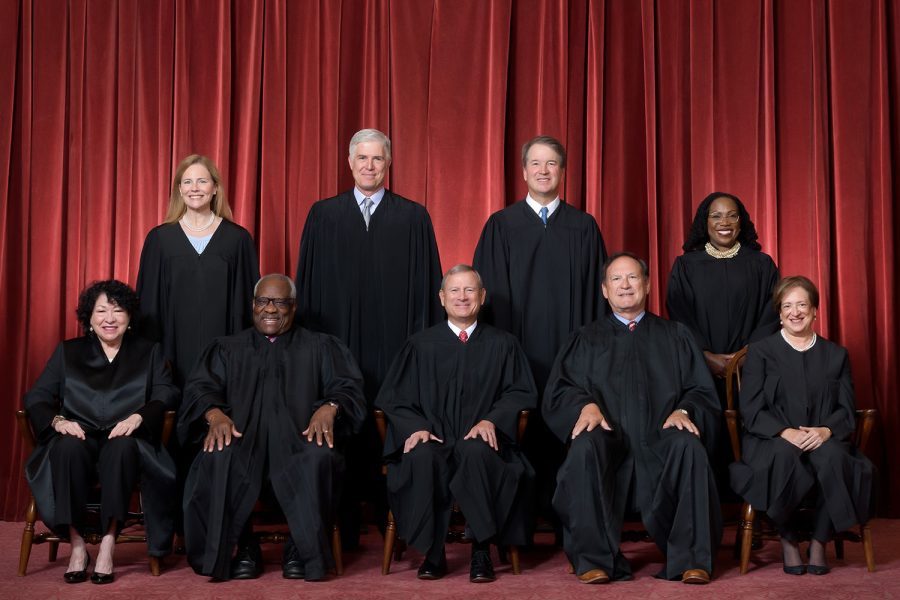Trump’s extreme policies live on in the Supreme Court
Formal group photograph of the Supreme Court as it was been comprised on June 30, 2022 after Justice Ketanji Brown Jackson joined the Court. The Justices are posed in front of red velvet drapes and arranged by seniority, with five seated and four standing. Seated from left are Justices Sonia Sotomayor, Clarence Thomas, Chief Justice John G. Roberts, Jr., and Justices Samuel A. Alito and Elena Kagan. Standing from left are Justices Amy Coney Barrett, Neil M. Gorsuch, Brett M. Kavanaugh, and Ketanji Brown Jackson. Credit: Fred Schilling, Collection of the Supreme Court of the United States
Perhaps future generations will look back on this chapter of American history and see each event strung together as a product of everything prior to it. Think of the butterfly effect without such a charming name. This moment is not a beautifully transforming butterfly taking gentle flight and changing the world around it without intention, but rather a violent slash of a knife. This moment is cold. This moment stings. This moment is a bloody one.
Maybe it will take an outside reflection to understand the full implications of this moment. But for now, I would at least like to highlight the irony of the Supreme Court as connected to Donald Trump, and what their overlap may say about the 2022 session. Bear with me.
Trump and the law: now there’s a story all on its own, and one I am in no position to analyze. Instead, let’s look at what he intended his impact to be when he flooded the court with his conservative peers: Neil Gorsuch, Brett Kavanaugh and Amy Coney Barrett.
His goal behind this ultra-conservative court was power without regard for precedent. When it comes to multiple — completely baseless — claims of election fraud or an attempt to hide financial records indicative of tax violations, Trump thought he was in control. He assumed he could pack the court with his own ideology, with justices who would take his side over law itself. He failed. Or, in his eyes, they failed him.
While this would be a lovely place to end the story — Politics cannot stand in the way of Law and Order! Justice is alive in America! — the knife keeps slashing.
As we’ve seen, those who celebrated the decision by the court to reject Trump’s emergency request to intervene after the Mar-a-Lago raid in August are not exactly safe from the court either. Yes, the court has proven itself not completely biased in following the rule of law over Trump’s lawless politics, but has it really swung the other way, in full support of liberal ideology? Are those opposed to Trump seeing themselves represented positively in law in areas he is not?
Well if you’ve had any takeaway from the Supreme Court this summer, it likely related to the reversal of Roe v. Wade, which had protected abortion access nationwide. Not only that, but the increasingly conservative Supreme Court also made it harder to regulate guns and limited the authority the Environmental Protection Agency has on curbing carbon emissions to limit the impacts of climate change.
So, what a dilemma this is; the court, a third of which was hand-picked by Trump himself, has failed both liberals and conservatives. Whether you agree or disagree with these decisions, both sides can find reason to disagree with the court at this given moment. But are these contentions equal?
Absolutely not.
Let’s take the case of Moore v. Harper, which is on the Supreme Court’s 2022 case docket. The case, in short, involves which legislative body has the power to determine how congressional elections are conducted. In swing states like Pennsylvania, that means that GOP-led legislatures could gain an “unlimited ability” to decide not only how elections are conducted, but also who wins them, according to Ian Millhiser for Vox. Gerrymandering is a large factor in this case, as is the Supreme Court itself, which, under even a “narrow reading” of the independent state legislature doctrine would give the Supreme Court power over the state court in interpreting election law.
This case, along with cases like Merrill v. Milligan — which could reinforce racial gerrymandering in states like Alabama — are still potential wins for the Trump-brand conservative.
This is where these contentions differ: Trump supporters will take issue with the Supreme Court in its denial of election fraud. Women, people of color and believers in climate change alike will take issue with the Supreme Court in its potential, or current, denial of their rights.
See the difference?
In letting his selfish attempt to escape the law tarnish the court for the upcoming years, we all suffer at the hands of Trump long after his presidency. He has created a court that looks poorly on his most egregious supporters and most fervent critics alike. Those who live, breathe and even die by the — false — notion that the election was stolen suffer. Those who support the rule of law when it cracks down on the rich and powerful are reminded of their place in the U.S. Supreme Court, be it as a woman seeking abortion, or as a queer person hoping that marriage equality will stick around long enough to experience it personally, or as a Black voter wishing that every vote was treated equally.
Trumpism, then, is woven into our country, whether we like it or not. The consequences of selfish choices by one man are to the detriment of people far more impacted than he himself ever will be.
So we wait. We wait patiently on decisions by this court and wait for things to change for those of us who had nothing to gain, only to continue living, under the U.S. Supreme Court. Only time will tell how deep the knife will cut.

Sam Heilmann is a sophomore from Johnstown, PA. She is majoring in Communications. This is her second year on the Campus staff, and her first as Opinion...





